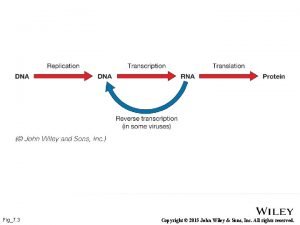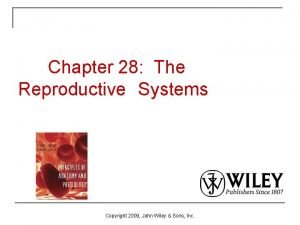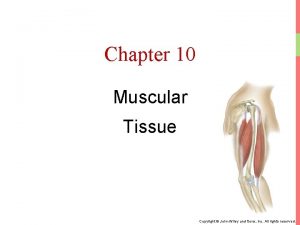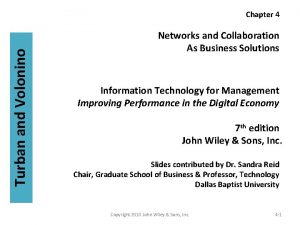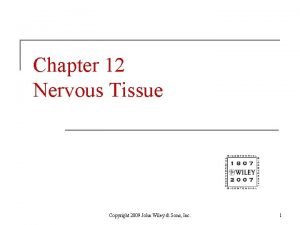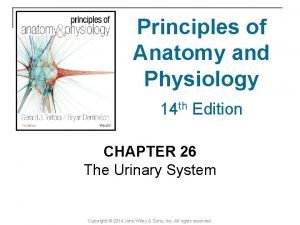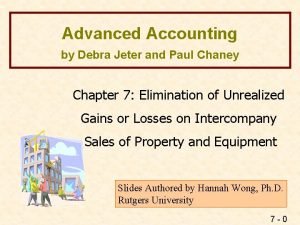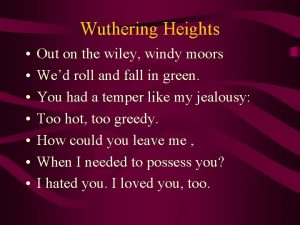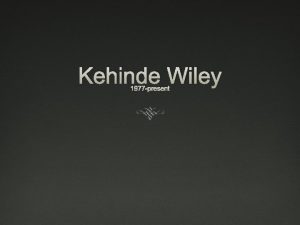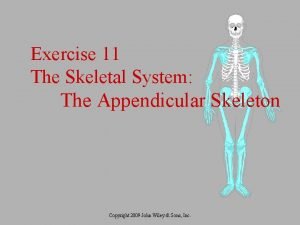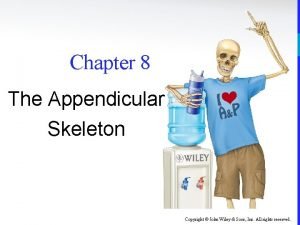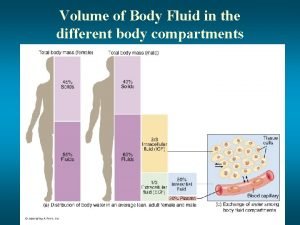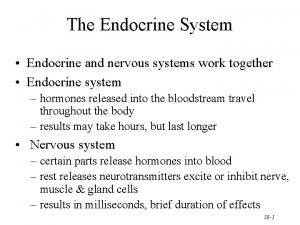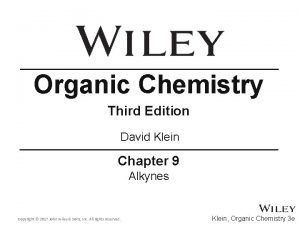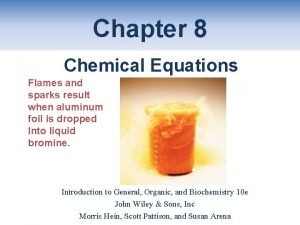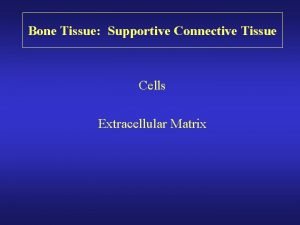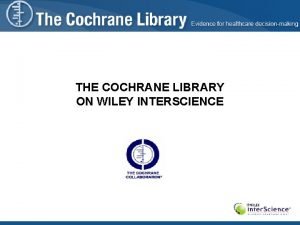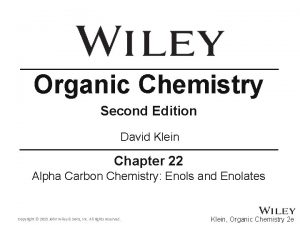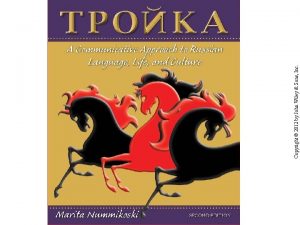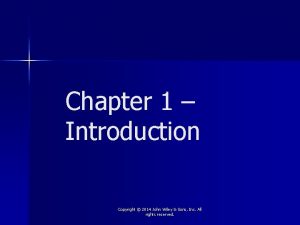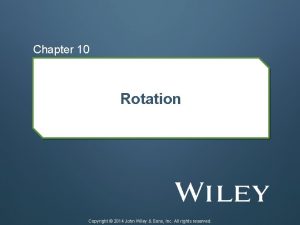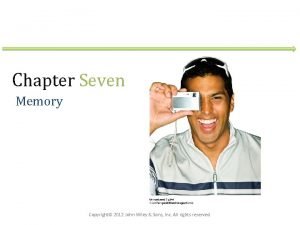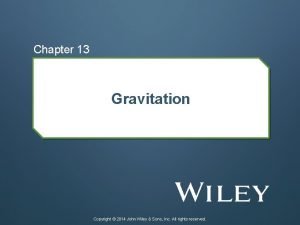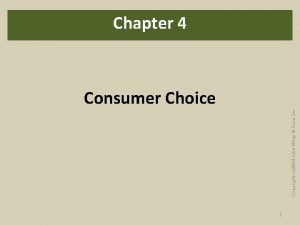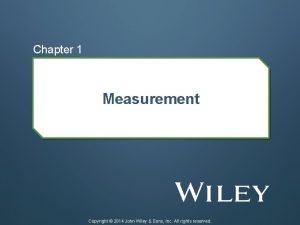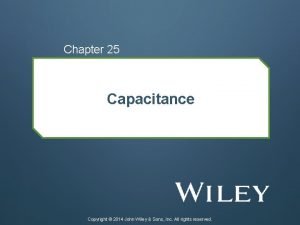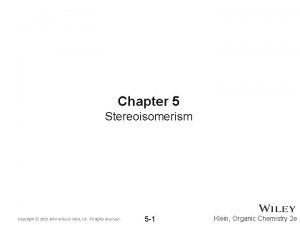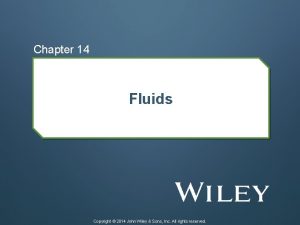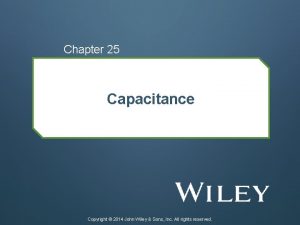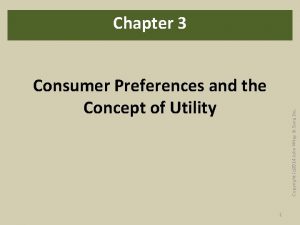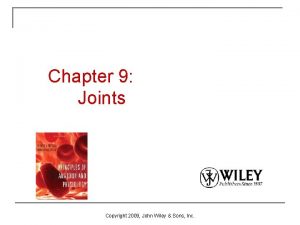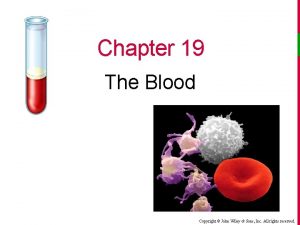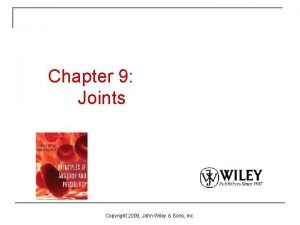Chapter 20 The Heart Copyright John Wiley Sons














































- Slides: 46

Chapter 20 The Heart Copyright © John Wiley & Sons, Inc. All rights reserved.

The Circulatory System v The heart is the pump of the circulatory system. • It weighs about 350 g (about the size of a closed fist), and it beats >10, 000 times per day. • The heart and blood vessels transport water, gases (O 2, CO 2), proteins and hormones throughout the body. • They also regulate temperature, blood p. H and facilitate the functions of the immune system. Copyright © John Wiley & Sons, Inc. All rights reserved.

Heart Location v The heart is located in the mediastinum, which extends from the sternum anteriorly to the vertebral column posteriorly, and lies medially between the two lungs and the pleural membranes that cover them. Copyright © John Wiley & Sons, Inc. All rights reserved.

Heart Location v 2/3 of the heart’s mass is just barely to the left of the midline. The base of the heart is tipped up medially and posteriorly, while the apex projects inferiorly and se laterally. Ba v Apex Copyright © John Wiley & Sons, Inc. All rights reserved.

The Pericardium v The pericardium is the membrane that surrounds and protects the heart and retains its position in the mediastinum (while allowing for some freedom of movement). Copyright © John Wiley & Sons, Inc. All rights reserved.

The Pericardium v The pericardium is composed of a tough outer fibrous layer lined by a delicate serous membrane. • The fibrous pericardium is a very dense and non-flexible connective tissue that helps protect and anchor the heart. Copyright © John Wiley & Sons, Inc. All rights reserved.

The Pericardium v The inner serous pericardium is subdivided into a parietal layer which adheres to the outermost fibrous layer and a visceral layer which is also viewed as the outer surface of the heart wall. v A thin pericardial fluid lubricates the space between the visceral and parietal pericardium. Copyright © John Wiley & Sons, Inc. All rights reserved.

Layers of the Heart Wall v The wall of the heart is composed of three distinct layers. From superficial to deep they are: • The epicardium • The myocardium • The endocardium Copyright © John Wiley & Sons, Inc. All rights reserved.

Layers of the Heart Wall v The epicardium, the thin, transparent outer layer of the heart wall, is also called the visceral layer of the serous pericardium. v The myocardium, the thick middle layer, is composed of cardiac muscle. v The endocardium is a simple squamous epithelium (known throughout the circulatory system as "endothelium”). Copyright © John Wiley & Sons, Inc. All rights reserved.

Layers of the Heart Wall Copyright © John Wiley & Sons, Inc. All rights reserved.

Chambers of the Heart v The heart has 4 Chambers: • The upper 2 are the right and left atria. • The lower 2 are the right and left ventricles. v Depending on the situation, the heart can be thought of as “right and left” pumps, or “top and bottom” pumps. Copyright © John Wiley & Sons, Inc. All rights reserved.

Chambers of the Heart v The “right heart” consists of the right atrium and right ventricle, taking venous blood from the body and pumping it to the lungs for oxygenation. v The "left heart" consists of the left atrium and left ventricle, taking freshly oxygenated pulmonary blood and pumping it systemically (meaning to the body). Copyright © John Wiley & Sons, Inc. All rights reserved.

Chambers of the Heart v The “top part of the heart” is a weak pump consisting of the right and left atria. It loads the ventricles by giving an “atrial kick” before the ventricles contract. v The "bottom part of the heart" is a strong pump consisting of the right and left ventricles. It’s the main pump for the pulmonary and systemic circuits. Copyright © John Wiley & Sons, Inc. All rights reserved.

Chambers of the Heart v Even without atrial function, blood flows passively down into the ventricles of the bottom heart. • The "atrial kick" is responsible for only a 20% increase in the amount of blood ejected by the ventricles important, but not essential. v There are many older persons in chronic atrial fibrillation (no atrial kick), that still manage to function very well. Copyright © John Wiley & Sons, Inc. All rights reserved.

Heart Valves v Blood always flows from an area of high pressure to an area of low pressure. v The flow of blood (dictated by differences in pressure, not muscles), operates the valves of the heart. v Valves operate in pairs: • Atrioventricular valves open to allow blood to flow from the atria into the ventricles. • Semilunar (outflow) valves open to allow blood to flow from the ventricles, into the outflow vessels. Copyright © John Wiley & Sons, Inc. All rights reserved.

Heart Valves v Atrioventricular (AV) valves are positioned at the entrance to the ventricles: • The right AV valve (also called the tricuspid valve because of its three leaflets or cusps) opens into the right ventricle. • The left AV valve (also called the bicuspid or mitral valve) opens into the left ventricle. Copyright © John Wiley & Sons, Inc. All rights reserved.

Heart Valves v The semilunar valves are positioned at the entrance to the outflow vessels leading into the pulmonary and systemic circulation: • The right outflow valve (also called the pulmonary valve) opens into the pulmonary trunk. • The left outflow valve (also called the aortic valve) opens into the aortic arch. Copyright © John Wiley & Sons, Inc. All rights reserved.

Heart Valves Copyright © John Wiley & Sons, Inc. All rights reserved.

Heart Valves Copyright © John Wiley & Sons, Inc. All rights reserved.

Heart Valves v As the ventricles start contracting, the closing AV valves are subject to strong forces. To prevent valve damage at an early age, the AV valves are tethered to the walls of the ventricles by “heart strings” (chordae tendineae) attached to papillary muscles. v The papillary muscles pull on the AV valves via the chordae tendineae, slowing their closure and preventing trauma to the valves. Copyright © John Wiley & Sons, Inc. All rights reserved.

Heart Valves Copyright © John Wiley & Sons, Inc. All rights reserved.

Valves v In contrast to the delicate, leafy folds of the AV valves, the semilunar valves have rather firm cusps that each look like a semi-full moon (semilunar). • Each cusp makes up about a third of the valve. Copyright © John Wiley & Sons, Inc. All rights reserved.

Valves v The outflow valves open with ventricular ejection and close when blood in the aorta and pulmonary outflow tracts begins to leak back into the ventricles. • The semilunar cusps act like sails, catching the blood and closing the valve. Copyright © John Wiley & Sons, Inc. All rights reserved.

Valves v Surprisingly, perhaps, there are no valves guarding the junction between the venae cavae and the right atrium or the pulmonary veins and the left atrium. As the atria contract, a small amount of blood does flow backward into these vessels, but it is minimized by the way the atria contract, which compresses, and nearly collapses the venous entry points. Copyright © John Wiley & Sons, Inc. All rights reserved.

Arteries and Veins v Arteries are vessels that always conduct blood away from the heart – with just a few exceptions, arteries contain oxygenated blood. v Most arteries in the body are thick-walled and exposed to high pressures and friction forces. Copyright © John Wiley & Sons, Inc. All rights reserved.

Arteries and Veins v Veins are vessels that always bring blood back to the heart - with just a few exceptions, veins contain deoxygenated blood. v Most veins in the body are thin-walled and exposed to low pressures and minimal friction forces. Copyright © John Wiley & Sons, Inc. All rights reserved.

Arteries and Veins v The major arteries that attach to the heart are the arch of the aorta (with its ascending and descending portions), the pulmonary trunk (with its left and right pulmonary arteries), and the coronary arteries. v The major veins that attach to the heart are the superior and inferior venae cavae, the 4 pulmonary veins, and the coronary sinus (on the back of the heart). Copyright © John Wiley & Sons, Inc. All rights reserved.

Arteries and Veins A cadaver dissection showing the major blood vessels in the anterior mediastinum Copyright © John Wiley & Sons, Inc. All rights reserved.

Blood Flow v The body’s blood flow can best be understood as two circuits arranged in series. The output of one becomes the input of the other: • Systemic circuit ejects blood into the aorta, systemic arteries, and arterioles and is powered by the left side of the heart. • Pulmonary circuit ejects blood into the pulmonary trunk and is powered by the right side of the heart. Copyright © John Wiley & Sons, Inc. All rights reserved.

Coronary Vessels v Only the innermost tissues lining the chambers of the heart can derive oxygen from the blood flowing through those chambers. • The myocardium (and other tissues of the thick cardiac walls) must get nutrients from blood flowing through the coronary circulation. • Even then, only during the relaxation phase of ventricular diastole, will blood actually flow through the coronary circulation. Copyright © John Wiley & Sons, Inc. All rights reserved.

Coronary Vessels v The coronary arteries and veins have been painted in this anterior view of a cadaver heart: Copyright © John Wiley & Sons, Inc. All rights reserved.

Coronary Vessels v Coronary veins all collect into the coronary sinus on the back part of the heart: • The coronary sinus empties into the right atrium where the deoxygenated coronary blood joins with oxygen-depleted blood from the rest of the body. Copyright © John Wiley & Sons, Inc. All rights reserved.

Cardiac Muscle Tissue v Cardiac muscle, like skeletal muscle, is striated. Unlike skeletal muscle, its fibers are shorter, they branch, and they have only one (usually centrally located) nucleus. v Cardiac muscle cells connect to and communicate with neighboring cells through gap junctions in intercalated discs. Copyright © John Wiley & Sons, Inc. All rights reserved.

Cardiac Conduction v The self-excitable myocytes that "act like nerves" have the 2 important roles of forming the conduction system of the heart and acting as pacemakers within that system. v Because it has the fastest rate of depolarization, the normal pacemaker of the heart is the sinoatrial (SA) node, located in the right atrial wall just below where the superior vena cava enters the chamber. Copyright © John Wiley & Sons, Inc. All rights reserved.

Cardiac Conduction v The action potential generated from the SA node reaches the next pacemaker by propagating throughout the wall of the atria to the AV node in the interatrial septum. v At the AV node, the signal is slowed, allowing the atrium a chance to mechanically move blood into the ventricles. Copyright © John Wiley & Sons, Inc. All rights reserved.

Cardiac Conduction v From the AV node, the signal passes through the AV bundle to the left and right bundle branches in the interventricular septum towards the apex of the heart. v Finally, the Purkinje fibers rapidly conduct the action potential throughout the ventricles. Copyright © John Wiley & Sons, Inc. All rights reserved.

Frontal plane Left atrium Right atrium 1 SINOATRIAL (SA) NODE 2 ATRIOVENTRICULAR (AV) NODE 3 ATRIOVENTRICULAR (AV) BUNDLE (BUNDLE OF HIS) 4 RIGHT AND LEFT BUNDLE BRANCHES Left ventricle Right ventricle 5 PURKINJE FIBERS Anterior view of. Copyright frontal©section John Wiley & Sons, Inc. All rights reserved.

The Electrocardiogram v An ECG is a recording of the electrical changes on the surface of the body resulting from the depolarization and repolarization of the myocardium. v ECG recordings measure the presence or absence of certain waveforms (deflections), the size of the waves, and the time intervals of the cardiac cycle. • By measuring the ECG, we can quantify and correlate, electrically, the mechanical activities of the heart. Copyright © John Wiley & Sons, Inc. All rights reserved.

The Electrocardiogram v An ECG recording can help us determine normal from abnormal cardiac activity: • Abnormal ECGs show problems within the conduction pathways, whether or not the heart is enlarged, or if certain regions are damaged. Copyright © John Wiley & Sons, Inc. All rights reserved.

The Electrocardiogram v The major deflections and intervals in a normal ECG include: • P wave - atrial depolarization • P-Q interval - time it takes for the atrial kick to fill the ventricles • QRS wave - ventricular depolarization and atrial repolarization • S-T segment - time it takes to empty the ventricles before they repolarize (the T wave) Copyright © John Wiley & Sons, Inc. All rights reserved.

1 Depolarization of atrial contractile fibers produces P wave 6 6 Ventricular diastole (relaxation) P Action potential in SA node 0 2 Atrial systole (contraction) 0. 2 Seconds P P 0 0. 2 0. 4 0. 6 0. 8 Seconds 5 Repolarization of 5 ventricular contractile fibers produces T wave 0 0. 2 Seconds 3 Depolarization of ventricular contractile fibers produces QRS complex T P 0 0. 2 0. 4 Seconds R 0. 6 4 Ventricular systole (contraction) P Q 0 S 0. 2 0. 4 Seconds P 0 0. 2 0. 4 Seconds Copyright © John Wiley & Sons, Inc. All rights reserved.

Blood Pressure v Blood Pressure is usually measured in the larger conducting arteries where the high and low pulsations of the heart can be detected – usually the brachial artery. • Systolic BP is the higher pressure measured during left ventricular systole when the aortic valve is open. • Diastolic BP is the lower pressure measured during left ventricular diastole when the valve is closed. Copyright © John Wiley & Sons, Inc. All rights reserved.

Cardiac Cycle v The cardiac cycle includes all events associated with one heartbeat, including diastole (relaxation phase) and systole (contraction phase) of both the atria and the ventricles. v In each cycle, atria and ventricles alternately contract and relax. • During atrial systole, the ventricles are relaxed. • During ventricle systole, the atria are relaxed. Copyright © John Wiley & Sons, Inc. All rights reserved.

Cardiac Cycle v Since ventricular function matters most to the body, the two principal events of the cycle for us to understand are ventricular filling (during ventricular diastole), and ventricular ejection (during ventricular systole). • The blood pressure that we measure in the arm is a reflection of the pressure developed by the left ventricle, before and after left ventricular systole. • Pulmonary blood pressure is a result of right ventricular function, but is not easily measured. Copyright © John Wiley & Sons, Inc. All rights reserved.

Cardiac Cycle v The average time required to complete the cardiac cycle is usually less than one second (about 0. 8 seconds at a heart rate of 75 beats/minute). • 0. 1 seconds – atria contract (atrial “kick”), ventricles are relaxed • 0. 3 seconds – atria relax, ventricles contract • 0. 4 seconds – relaxation period for all chambers, allowing passive filling. When heart rate increases, it’s this relaxation period that decreases the most. Copyright © John Wiley & Sons, Inc. All rights reserved.

Cardiac Output v The stroke volume (SV) is the volume of blood ejected from the left (or right) ventricle every beat. The cardiac output (CO) is the SV x heart rate (HR). • In a resting male, CO = 70 m. L/beat x 75 beats/min = 5. 25 L/min. v A person’s entire blood volume flows through the pulmonary and systemic circuits in less than a minute. Copyright © John Wiley & Sons, Inc. All rights reserved.
 John wiley & sons, incorporated
John wiley & sons, incorporated John wiley & sons
John wiley & sons Chapter 10 muscle tissue
Chapter 10 muscle tissue Copyright search
Copyright search Organic chemistry
Organic chemistry Action potential strength
Action potential strength Wiley and sons
Wiley and sons There was a man who had four son
There was a man who had four son There was a man who had
There was a man who had John wiley
John wiley Onlinelibrary-wiley-com
Onlinelibrary-wiley-com Genie wiley nature vs nurture
Genie wiley nature vs nurture Debra jeter
Debra jeter Genie wiley
Genie wiley Wuthering heights themes
Wuthering heights themes Kehinde wiley bio
Kehinde wiley bio Management information systems wiley
Management information systems wiley Chris ofili afrodizzia
Chris ofili afrodizzia Rist bone
Rist bone Www.interscience.wiley.com
Www.interscience.wiley.com Elbow joint diagram
Elbow joint diagram Ward v wilbanks
Ward v wilbanks Wiley
Wiley Osmoreceptors
Osmoreceptors Vasopressin function
Vasopressin function Reaction of alkyne
Reaction of alkyne Doc praxisklinik im wiley
Doc praxisklinik im wiley Chemical reaction of phosphorus
Chemical reaction of phosphorus Wiley
Wiley Cochrane wiley
Cochrane wiley Wiley
Wiley Dullness to percussion
Dullness to percussion Sheep heart diagram
Sheep heart diagram Heart to heart merrylands
Heart to heart merrylands Hình ảnh bộ gõ cơ thể búng tay
Hình ảnh bộ gõ cơ thể búng tay Ng-html
Ng-html Bổ thể
Bổ thể Tỉ lệ cơ thể trẻ em
Tỉ lệ cơ thể trẻ em Voi kéo gỗ như thế nào
Voi kéo gỗ như thế nào Thang điểm glasgow
Thang điểm glasgow Hát lên người ơi
Hát lên người ơi Các môn thể thao bắt đầu bằng từ đua
Các môn thể thao bắt đầu bằng từ đua Thế nào là hệ số cao nhất
Thế nào là hệ số cao nhất Các châu lục và đại dương trên thế giới
Các châu lục và đại dương trên thế giới Công của trọng lực
Công của trọng lực Trời xanh đây là của chúng ta thể thơ
Trời xanh đây là của chúng ta thể thơ Cách giải mật thư tọa độ
Cách giải mật thư tọa độ
